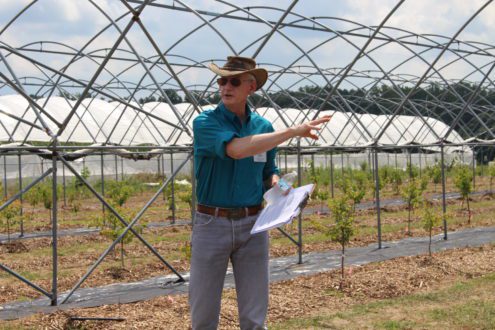Aug 16, 2017Peach varieties, fruit growing techniques shown at Michigan Extension tour
About 40 individuals attended a field day Wednesday, Aug. 16 at Michigan State University’s (MSU) Southwest Michigan Research and Extension Center (SWMREC) near Benton Harbor.
The tours and presentations on projects affecting a wide variety of crops from cucumbers to hops to blueberries and peaches.
The tour kicked off with a presentation on a second-generation of research into high tunnels for fruit trees and bushes. High tunnel research has been underway at other MSU facilities in Clarksville, SWMREC and the MSU campus Hort Farm since 2005. New in the spring of 2017 were several new tree fruit research projects at SWMREC.
MSU researcher Greg Lang spoke about one of the new trials comparing rootstocks of fruit trees. While for some time there have been few choices for rootstock for stonefruit, there now appears to be a good selection of vigor-limiting peach and cherry rootstocks available for commercial production. Potted raspberries – to be precise, raspberries grown in bags – were also grown in the high tunnels in a series of experiments run by MSU Horticulture professor Eric Hanson. The pots can help growth and keep the plants mobile for winter storage, and protect the plants from bad soil if the ground is contaminated, but also require multiple watering sessions per day.
MSU lab manager Kristin Poley discussed trials for a variety of alternative treatments for managing nematodes in the soil. One of the treatments being evaluated is Sun Hemp, a tropical legume that will grow 3-6 feet before being cut down and worked into the soil. Other treatments included a high-rate of chicken manure, and soil “solar-ization” – using a spread of clear plastic to heat the ground, killing off nematodes. Poley added that a downside to this last treatment was that helpful bacteria and micro-organisms would also be killed off. Cucumbers will be planted on the trial grounds to measure their effect.
MSU Assistant Professor of Horticulture Zachary Hayden spoke about testing different organic sources of nitrogen on a cucumber plot. Some of the materials tested included dried blood meal and soybean meal, he said.
Professor Mary K. Hausbeck discussed prevention and control of downy mildew and related plant diseases. “Once they get a leg up on you, they’re really hard to reign in,” she said. Some fungicides that were once effective against the disease are no longer working well, she said. Graduate Student Douglas S. Higgins spoke about his research into preventing downy mildew of hops.
Entomology Professor Rufus Isaacs spoke about research to find plants to help sustain pollinators like bees. So far, the group has found 25-27 species that are attractive to pollinators. He also discussed efforts to get eradicate post-harvest blueberry maggots – this research is of great interest for international trade of blueberries, he said. The Blueberry Maggot fly is native to the eastern U.S., including Michigan. Methyl bromide has been used for fumigation treatments but is being phased out in many applications. Isaacs added that Spotted Wing Drosophila is being adequately managed by most blueberry growers.
MSU Extension Educator Ronald Goldy his work on various trials of vegetable varieties for tomatoes, russet potatoes, Harris Moran Zucchini, pickle cucumbers, slicing cucumbers and russet potatoes. Currently, the tomato patch is shielded from crows by streamers, but Goldy said he used to use dead crows to keep the others away. Each dead crow takes keeps about 200 feet clear in each direction, he said.
“It’s an old farmers’ trick, but it works,” he said.
Senior MSU Extension educator Bill Shane led a tour of peach varieties under development at SWMREC. Most MSU peach breeding crosses are aimed at developing improved varieties with yellow, “melting” flesh with an increased red skin color, size, firmness and flavor. But there are a few exceptions: Shane also has targeted the development of improved white-fleshed peach varieties with better size, flesh firmness, cold hardiness, and bacterial spot resistance. During the tour, he also mentioned it was possible to get a peach skin color that seems too bright red, like a raw steak.
The tour ended with a presentation on peaches, and participants were invited to try dozens of recently-harvested varieties, and submit their own notes.
Above, MSU researcher Greg Lang talks about trials for fruit tree high tunnels.
— Fruit Growers News Assistant Editor, Stephen Kloosterman















